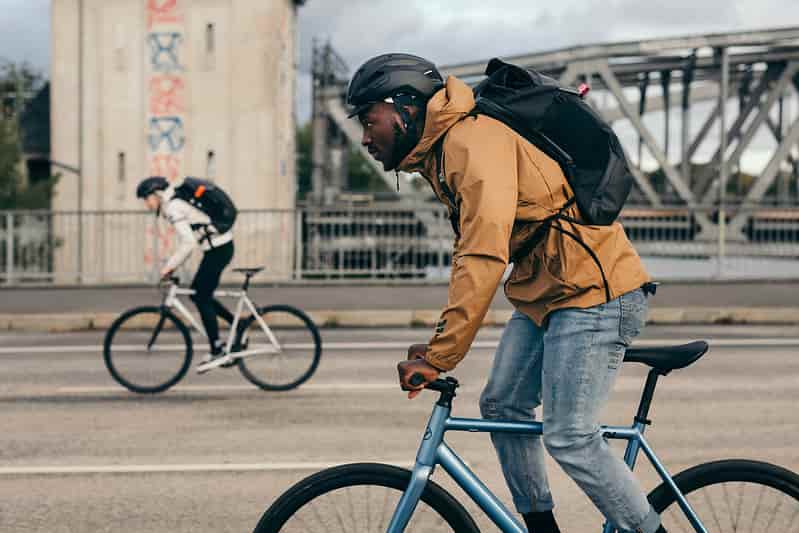It is common knowledge that exercise is vital for maintaining a healthy lifestyle. Health and wellbeing professionals often promote cycling as their choice of exercise as it is a method of cardiovascular fitness and fat burning, while it also supports muscle strength and improvement.
In addition to providing physical and mental health benefits, choosing to cycle is also a cost-effective, convenient, and environmentally friendly way to exercise.
Recent years have seen an increase in the number of US citizens who chose to cycle as their preferred method of transport to work or College. This increase is great news for individuals’ health and their carbon footprint.
While cycling is associated with healthy lifestyle, it often lead to back and shoulder issues especially with heavy backpacks. Backpacks are supposed to alleviate pain, not create it.
But when worn incorrectly, or with to much weight they put too much stress on the joints, ligaments, and muscles. Your back while tries to compensate for the extra weight, it become stiff, sore and cause pain.
While your poor core strength has something to do with it, but sometimes improper riding position and saddle height play a role. Make sure you sit in a comfortable position with handlebar reach not too long.
To avoid back pain cyclists need to ensure that their bikes are set up correctly for their individual needs. This means correct positioning and placement of seat and handlebars to avoid overstretching and straining.
This is something that should be done with the supervision of a professional. Additionally, there should always be a warmup period before a ride, followed by a cool-down period following a ride.
Is Cycling With a Backpack Bad For Your Back?
It certainly can be, but it doesn’t have to be, a few moderation can make things better and more comfortable.
Riding a bike with a backpack can cause sore back muscles and nerves resulting in short-term, and longer-term, back pain. Some people may not immediately feel the negative effects, particularly in the early days.
However, over time the pain and discomfort can gradually occur. Once the pain has started it generally increases over time, unless changes are made.
When it comes to wearing a backpack while cycling the root of the problem is the additional weight and strain on the back. A bag worn on the back, especially one which is overloaded and therefore heavy, will create stress and pressure on your spine and the muscles of your back.
Over time this can eventually lead to painful symptoms.
Once the painful symptoms have started it can discourage an otherwise keen cyclist to continue their passion and, unfortunately, many people have stopped cycling due to back pain.
However, changes can be made. A few simple alterations can make a huge difference and stop problems.
These changes can allow cycle enthusiasts to continue wearing a backpack whilst riding without suffering any painful or unpleasant consequences.
How Do I Know If My Backpack Is a Problem?
When you have sore muscles with pain in your shoulder and upper back; your backpack may be the problem. This is true in most cases but not always!
As using a bike that isn’t properly adjusted to fit your body, using wrong cycling posture, improper bicycle/handlebar or having poor core strength also leads to back and shoulder issues.
So how will you know if your backpack is the problem? Well the simple method is to check if your backpack is too heavy or has improper construction.
A nice backpack should have two wide padded straps that go over your shoulders. This helps distribute weight evenly spread out across your body. If possible go for the widest strap possible.
If you have regular back pain, finds it harder to put on and off your backpack or needs to lean forward when carrying them, has just one or narrow strap; then its your backpack that is the troublemaker.

Changes That Can Be Made
As with most physical complaints prevention is better than cure. So if you currently ride whilst wearing a backpack and suffer little to no problems with your back consider making these changes anyway.
It is easier to prevent a back issue than cure one later on down the line.
Prevention physical activity is a great place to start. Things such as physical therapy, stretching and yoga are all great ways to prevent future strains.
Speaking to a professional physical therapist or yoga instructor and explaining a typical journey and average weight carried in a backpack will give you a starting point.
A professional will know which muscle groups are most likely to be impacted and what can be done before and after. A short stretching and strengthening routine carried out on a regular basis could make all the difference and enable many to continue carrying a bag whilst they cycle.
Lightening the load is another positive step in the right direction. If extra weight is causing problems then consideration should be given to what is essential to carry and what could be removed.
If cycling for fun at the weekend take essential/ emergency supplies only such as water, travel size first aid kit, phone, and portable charger for those in case of emergency moments.
Those who cycle with friends and family should think about splitting supplies between individuals to create several very light loads rather than one heavy, overbearing backpack.
Another great change is choosing a bag with wider backpack straps that position placement across the shoulders, rather than the neck. By spreading the weight there is less strain in one area.
A narrow strap would concentrate the load to a smaller area causing irritation to muscles and nerves.
Wearing a backpack lower can also make a huge difference to cyclists’ comfort, particularly if a heavy load is unavoidable.
This can easily be achieved with most backpacks by loosening the shoulder straps and making them longer. This adjustment will ensure that the bulk is closer to the lower back than the upper back.
This reposition will gently pull down the cyclist and contribute to a better posture.
Alternative Choice
There may be some who trial the changes suggested but still feel irritation and discomfort. Or some who simply cannot lighten their load due to the length and type of cycling journey they are embarking upon.
These cyclists do not need to hang up their helmets just yet, there is an alternative to try. Panniers are popular in the cycling world, particularly for those who dislike backpacks.
More expensive, panniers are a different experience to backpacks as they are fixed to your bike, rather than carried by the cyclist, giving back muscles a well-deserved rest.
Attaching Panniers on a Road Bike will offer many advantages.
- First, Panniers offer great storage space, along with better scope of organizing the luggage.
- They are handy for carrying a single large dimension unit.
- Panniers’ racks contribute to firmness and enhanced balance, which boosts the rider’s confidence.
- They save effort in packing/unpacking and carrying the luggage significantly.
Panniers are easily visible to co-travelers on the road, no matter in what vehicle and at what speed they are moving. This enhances safety and increases the chances of on-road co-operation.
Also Read,
Touring Bike vs Mountain Bike: 11 Major Differences
15 Best Hybrid Bike Brands 2023 | Bicycle Guide









Thank you for sharing